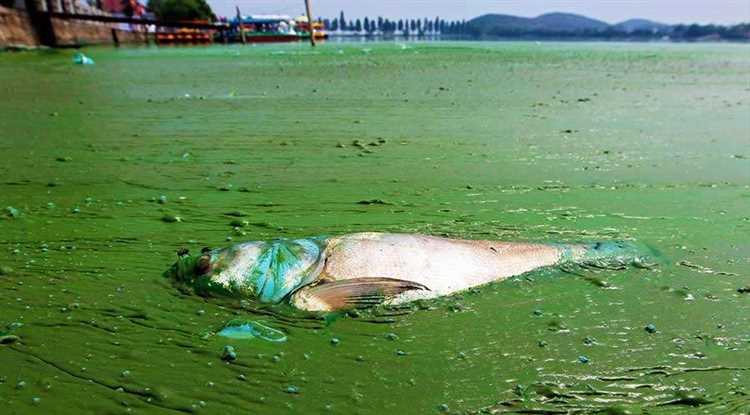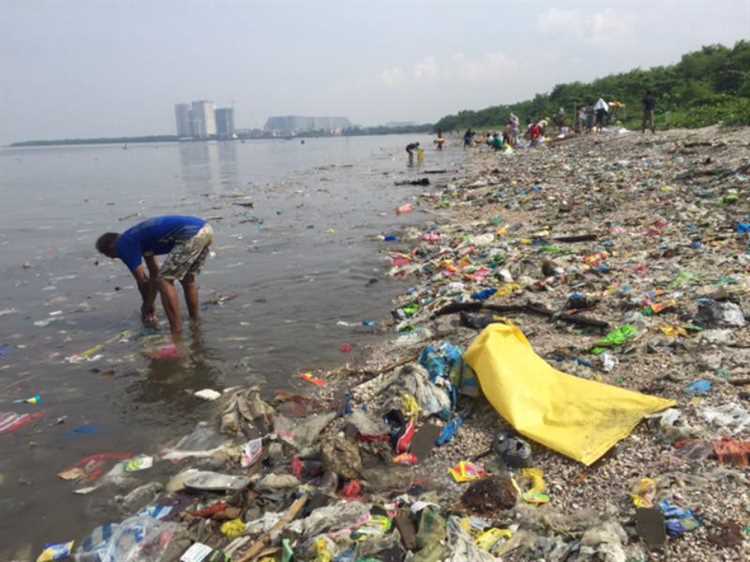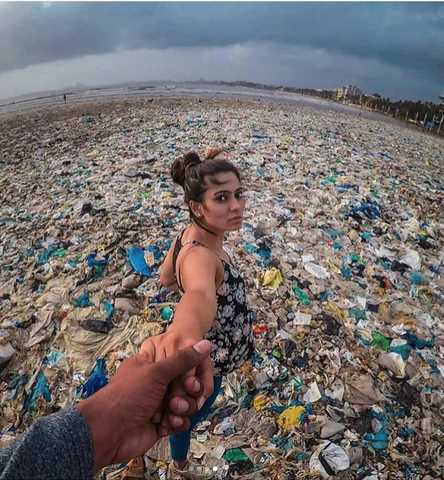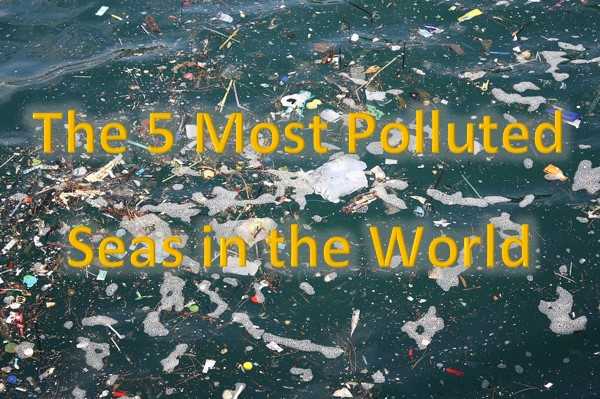
The world’s seas and oceans are some of the most stunning and awe-inspiring natural wonders on our planet. However, hidden beneath their shimmering beauty lies a dark secret – the alarming levels of pollution that plague these vast bodies of water. Among all the oceans in the world, there exists one that reigns supreme when it comes to filth and contamination, earning its notorious title of “The Filthiest Ocean in the World.”
Located in the heart of the industrialized world, this ocean serves as a dumping ground for a myriad of pollutants, ranging from plastics and chemicals to heavy metals and oil spills. The magnitude of pollution is simply staggering, with marine life and ecosystems suffering the consequences of human negligence. The once thriving habitats are now struggling to survive in this toxic environment, an environment that humans are ultimately responsible for.
Despite efforts from environmental organizations and governments to address the issue, the battle to clean up this ocean seems insurmountable. The sheer scale and complexity of the pollution problem pose numerous challenges, including lack of effective waste management systems, overconsumption, and unchecked industrialization. As a result, the contamination continues to worsen, demonstrating the dire need for immediate action and global cooperation to salvage what remains of this once-pristine expanse of water.
- The Devastating Impact of Pollution
- Understanding the Environmental Crisis
- Impact on Human Health
- Sustainable Solutions
- Identifying the Culprit: Human Activities
- The Most Polluted Sea: Seeking Answers
- The Facts
- The Causes
- Possible Solutions
- The Alarming State of the Ocean
- The consequences of pollution are far-reaching
- The need for urgent action
- The Global Efforts for Restoration
- International Cooperation and Partnerships
- Sustainable Practices and Technology
- Q&A
- What is the most polluted sea in the world?
- What are the main sources of pollution in the Mediterranean Sea?
- How does pollution affect marine life in the Mediterranean Sea?
- What measures are being taken to clean up the Mediterranean Sea?
The Devastating Impact of Pollution

Pollution has far-reaching consequences for our oceans, with devastating effects on marine life, ecosystems, and ultimately, human health.
1. Loss of Biodiversity: Pollution disrupts the delicate balance of marine ecosystems, leading to a loss of biodiversity. Chemical pollutants can harm or kill marine organisms, and plastic waste can entangle or choke marine animals. As a result, species diversity decreases, leading to a less resilient and less productive ecosystem.
2. Destruction of Habitats: Pollution, particularly from industrial and agricultural activities, contributes to the destruction of vital marine habitats such as coral reefs and seagrass beds. Chemical contaminants and excess nutrients can lead to coral bleaching and the death of seagrass, depriving countless marine species of their homes and food sources.
3. Contamination of the Food Chain: Pollutants and toxic substances accumulate in the tissues of marine organisms, entering the food chain and posing risks to human health. Predatory fish at the top of the food chain, such as sharks and tuna, can accumulate high levels of pollutants, including heavy metals and persistent organic pollutants, which can be harmful if consumed by humans.
4. Negative Health Impacts: Pollution not only affects marine ecosystems but also poses direct threats to human health. Pollution-contaminated seafood can lead to various health problems in humans, including neurological disorders, reproductive issues, and an increased risk of cancer. Additionally, coastal communities heavily dependent on the ocean for livelihood and sustenance may suffer economically and socially due to pollution-related impacts.
5. Climate Change and Ocean Acidification: Pollution, particularly greenhouse gas emissions, contributes to climate change and ocean acidification. Rising sea temperatures and increased carbon dioxide levels have cascading effects on marine ecosystems, such as coral bleaching, altered fish distribution, and reduced shellfish populations. These changes further exacerbate the impacts of pollution on the ocean.
In conclusion, pollution has dire consequences for the world’s oceans, threatening marine life, ecosystems, and human well-being. It is imperative that we take immediate action to reduce pollution levels and protect our oceans for future generations.
Understanding the Environmental Crisis
The environmental crisis is a global issue that affects every living organism on our planet. It is caused by human activities that release harmful pollutants into the air, water, and soil, leading to devastating effects on the ecosystems and biodiversity.
One of the key contributors to the environmental crisis is pollution. Industrial activities, transportation, and agriculture are major sources of pollution, releasing toxic substances such as carbon dioxide, sulfur dioxide, and nitrogen oxide into the atmosphere. These pollutants contribute to air pollution, climate change, and ocean acidification, threatening the survival of marine life and causing imbalances in the global climate system.
Deforestation is another significant factor contributing to the environmental crisis. The destruction of forests not only leads to the loss of biodiversity but also results in soil erosion, reduced water quality, and disrupted natural habitats. It also contributes to the release of carbon dioxide, as trees absorb this greenhouse gas and turn it into oxygen through photosynthesis.
Impact on Human Health
The environmental crisis also poses a significant threat to human health. Exposure to polluted air and water can lead to respiratory and cardiovascular diseases, while contaminated soil can contaminate the food we eat, exposing us to toxic substances. The rapid spread of diseases, such as zoonotic diseases, is also linked to the destruction of natural habitats and the close proximity between humans and wildlife.
Sustainable Solutions
To address the environmental crisis, sustainable solutions need to be implemented. This includes transitioning to renewable sources of energy, such as solar and wind power, reducing emissions from transportation and industries, implementing effective waste management strategies, and promoting conservation and reforestation efforts. It also requires educating and raising awareness among individuals and communities about the importance of protecting the environment and adopting eco-friendly practices in their daily lives.
By understanding the environmental crisis and taking action to mitigate its effects, we can create a healthier and more sustainable future for ourselves and future generations.
Identifying the Culprit: Human Activities
The pollution found in the world’s filthiest ocean is primarily caused by human activities. From industrial waste to plastic litter, humans have left an indelible mark on the health of this body of water.
One of the main culprits is industrial pollution. Factories and manufacturing plants release vast amounts of untreated waste into nearby rivers and streams, which eventually make their way to the ocean. Chemicals, heavy metals, and other hazardous materials contaminate the water and harm marine life.
The improper disposal of plastic waste is another significant contributor to the ocean’s pollution. Plastic products take hundreds of years to decompose, and many end up finding their way into the ocean. These plastics not only degrade the aesthetic appeal of the sea but also pose a severe threat to marine animals. Animals often mistake plastic debris for food and consume them, leading to severe health issues and even death.
| Human Activities | Contribution to Pollution |
|---|---|
| Industrial pollution | Release of untreated waste containing chemicals and heavy metals |
| Improper disposal of plastic waste | Plastics taking hundreds of years to decompose and posing a threat to marine animals |
Furthermore, urbanization and population growth have increased the demand for resources, leading to larger-scale extraction activities. Oil spills, for example, occur during the exploration, extraction, and transportation of oil. These spills devastate marine ecosystems, killing marine life and destroying habitats for years.
In addition to these direct sources of pollution, human activities also contribute to the ocean’s pollution indirectly. Climate change, primarily driven by human activities, has resulted in rising sea temperatures, ocean acidification, and increased frequency of extreme weather events. These changes have serious consequences for marine ecosystems and exacerbate existing pollution problems.
In conclusion, human activities are the primary culprit behind the pollution found in the world’s filthiest ocean. From industrial pollution to improper disposal of plastic waste, our actions have had significant negative impacts on this fragile ecosystem. It is crucial that we take immediate action to address these issues and work towards a cleaner and healthier ocean for future generations.
The Most Polluted Sea: Seeking Answers
As the world becomes increasingly aware of the devastating effects of pollution on our oceans, one sea stands out as the most polluted of them all. The _________________ is facing an environmental crisis with no easy solution in sight.
The Facts
The pollution in the _________________ is staggering. From plastic waste to chemical contaminants, the sea is filled with harmful substances that are destroying its delicate ecosystem. The sea is home to a wide range of marine life, from fish to mammals, and these pollutants are not only affecting their health but also entering the food chain and potentially impacting human health.
A study conducted by _________________ found that the concentration of pollutants in the sea is far above acceptable levels. It revealed alarming levels of heavy metals, microplastics, oil spills, and other hazardous materials. These findings have raised concerns and prompted calls for action.
The Causes
The pollution in the _________________ can be attributed to a variety of sources. One of the primary culprits is industrial activity. Factories and manufacturing plants in the surrounding areas release harmful chemicals and waste directly into the sea. Additionally, inadequate waste management systems contribute to the problem, as trash and other pollutants make their way into the sea through rivers and streams.
The _________________ is also heavily affected by marine transportation. Ships and boats that traverse the sea often release oil and other pollutants, leading to oil spills and contamination. The fishing industry is another major contributor, with discarded nets and gear adding to the already immense pollution problem.
Possible Solutions
Addressing the pollution in the _________________ will require a multi-faceted approach. Improving waste management systems and implementing stricter regulations on industrial activity are essential steps in reducing pollution. Recycling and proper disposal of plastics will also play a crucial role.
Controlling marine transportation practices and enforcing stricter regulations on oil spills will be vital in preventing further pollution. Supporting sustainable fishing practices and educating fishermen about the importance of proper waste disposal will also contribute to a cleaner and healthier sea.
| Pollutants | Effects |
|---|---|
| Chemical contaminants | Health problems for marine life and potential impacts on human health |
| Plastic waste | Destruction of marine ecosystems and harm to marine life |
| Oil spills | Contamination of water, soil, and wildlife |
| Heavy metals | Accumulation in marine organisms and potential toxicity in the food chain |
The Alarming State of the Ocean
The ocean, once a pristine and abundant ecosystem, is now facing a crisis of pollution and degradation.
Human activities have taken a toll on the health of the oceans, with pollution being one of the primary culprits. The discharge of toxic chemicals, industrial waste, and plastic pollution has contaminated the waters, threatening the survival of marine life and ecosystems.
Plastic pollution, in particular, has reached staggering levels. Every year, millions of tons of plastic waste end up in the ocean. Microplastics, tiny fragments of plastic, have become ubiquitous, posing a severe threat to marine organisms. From turtles mistaking plastic bags for jellyfish to seabirds consuming plastic particles, the impact of plastic pollution is devastating.
The consequences of pollution are far-reaching
This pollution not only affects marine life but also has significant consequences for humans. Marine pollution can contaminate seafood, making it unsafe for consumption and jeopardizing the livelihoods of fishing communities. Additionally, the release of harmful chemicals into the oceans can accumulate in the food chain, eventually affecting human health.
The need for urgent action

The alarming state of the ocean calls for immediate action to reduce pollution and protect this vital ecosystem. International cooperation, stricter regulations, and innovative solutions are required to tackle this global problem. Education and awareness campaigns are also crucial to change behaviors and promote sustainable practices.
It is imperative that individuals, governments, and industries make a concerted effort to reduce pollution and restore the health of the ocean. By taking action now, we can ensure a healthier and more sustainable future for both marine life and humanity.
The Global Efforts for Restoration

The pollution of the world’s oceans has reached alarming levels, and concerted global efforts are underway to restore these valuable ecosystems. Governments, international organizations, and environmental activists are joining forces to tackle the challenges posed by ocean pollution and work towards a cleaner and healthier future.
International Cooperation and Partnerships
The need for global action on ocean restoration has been recognized by many countries, leading to the establishment of international cooperation and partnerships. One such example is the United Nation’s Sustainable Development Goal 14, which calls on countries to conserve and sustainably use the oceans, seas, and marine resources for sustainable development. Through this goal, countries are encouraged to work together and implement measures to reduce marine pollution and restore damaged ecosystems.
In addition to international agreements, various organizations and initiatives have been formed to address ocean pollution. The Global Partnership on Marine Litter, for instance, brings together governments, industries, organizations, and individuals from around the world to find innovative solutions to tackle marine litter. This partnership aims to reduce the amount of plastic and other debris entering the oceans and promote the implementation of waste management strategies.
Sustainable Practices and Technology
In order to restore the oceans, it is crucial to adopt sustainable practices on both individual and industrial levels. Governments are implementing stricter regulations on waste disposal, encouraging the use of environmentally friendly alternatives, and promoting recycling programs. Industries are also investing in cleaner technologies and implementing more sustainable practices to reduce their environmental footprint.
Furthermore, technological advancements are playing a significant role in ocean restoration efforts. Innovative tools such as remote sensing, artificial intelligence, and underwater robots are being utilized to monitor and clean up pollution hotspots. These technologies enable scientists and researchers to gather valuable data, identify sources of pollution, and develop effective strategies for restoration.
But restoration efforts go beyond technology and regulations. They also require a shift in mindset and behavior. Individuals must recognize the impact of their daily choices and make conscious decisions to reduce their carbon footprint and protect the oceans. By adopting sustainable lifestyles, such as reducing plastic consumption, recycling, and supporting eco-friendly initiatives, we can all contribute to the restoration of the world’s oceans.
In conclusion, the global efforts for ocean restoration involve international cooperation and partnerships, sustainable practices, and the use of advanced technology. By working together and making conscious choices, we can restore the health and beauty of our oceans for future generations.
Q&A
What is the most polluted sea in the world?
The most polluted sea in the world is the Mediterranean Sea.
What are the main sources of pollution in the Mediterranean Sea?
The main sources of pollution in the Mediterranean Sea are industrial waste, sewage, agricultural runoff, and marine traffic.
How does pollution affect marine life in the Mediterranean Sea?
Pollution in the Mediterranean Sea has a detrimental effect on marine life, leading to the decline of certain species, coral bleaching, and the disruption of the ecosystem.
What measures are being taken to clean up the Mediterranean Sea?
Efforts are being made to clean up the Mediterranean Sea through various initiatives such as waste management programs, stricter regulations on industrial waste disposal, and the promotion of sustainable fishing practices.